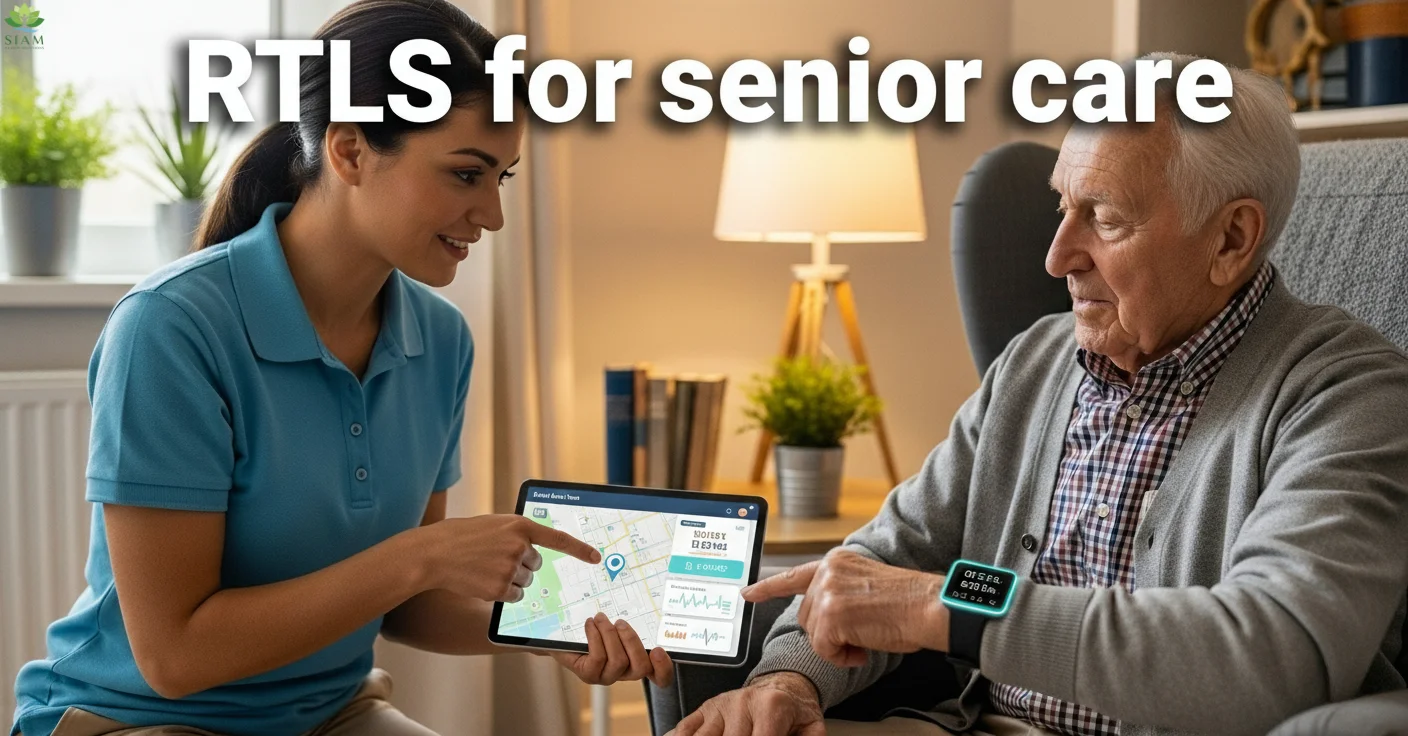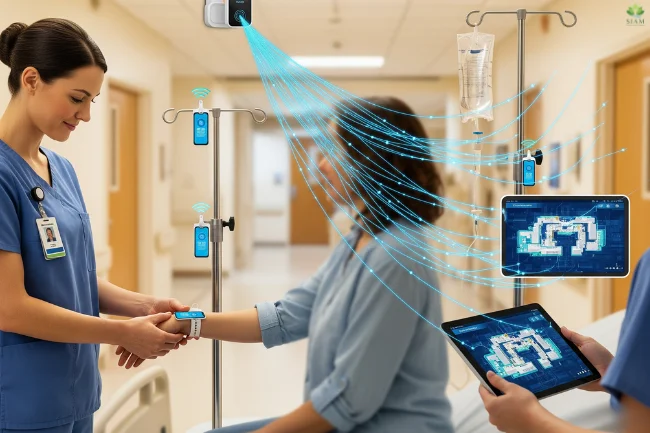In today’s fast-paced world, the need for innovative solutions in senior care has never been more critical. One such solution that is gaining popularity is RTLS for senior care. Real-Time Location Systems (RTLS) are transforming how senior care facilities manage their operations, ensuring safety, improving care quality, and streamlining staff workflows. In this article, we’ll explore what RTLS is, its benefits for senior care, and how it’s improving the lives of both elderly patients and healthcare providers.
What is RTLS for Senior Care?
RTLS, or Real-Time Location Systems, is a technology that allows organizations to track the location of assets, people, or equipment in real-time. In the context of senior care, RTLS for senior care involves using wireless sensors and tags to monitor and track the movement of both patients and staff within a care facility. By delivering valuable insights, these systems contribute to better efficiency, heightened safety, and an improved overall care experience.
RTLS systems typically use a combination of radio frequency identification (RFID), infrared sensors, and GPS technology to track movements in real-time. For senior care facilities, this technology plays a crucial role in improving operational management and patient safety.
Benefits of RTLS for Senior Care
1. Enhanced Patient Safety
One of the most significant benefits of RTLS for senior care is its ability to enhance patient safety. For elderly patients, especially those with dementia or mobility challenges, wandering is a common concern. RTLS helps caregivers track the exact location of patients, alerting them immediately if a patient wanders into a restricted area or leaves a designated zone.
This proactive approach can help prevent dangerous situations, such as patients wandering outside the facility or into unsafe areas like stairwells or kitchens. The system can trigger alerts, allowing staff to quickly intervene and guide the patient back to a safe location.
2. Improved Caregiver Efficiency
RTLS for senior care doesn’t just benefit the patients—it also streamlines workflows for caregivers. By knowing the real-time location of patients and equipment, caregivers can save time searching for necessary resources. Whether it’s a wheelchair, oxygen tank, or medication, RTLS allows staff to locate essential equipment quickly, improving efficiency and reducing downtime.
Furthermore, the system can help with staffing optimization by providing data on patient needs and caregiver workload. This ensures that resources are allocated effectively and that patients receive timely care without unnecessary delays.
3. Real-Time Monitoring and Alerts
Another significant advantage of RTLS for senior care is its ability to provide real-time monitoring and alerts. Staff can receive instant notifications regarding critical events, such as falls, wandering patients, or changes in a patient’s condition. These alerts allow caregivers to respond immediately, potentially preventing further injury or health complications.
Real-time data also helps management make informed decisions about resource allocation, ensuring that high-demand areas receive adequate attention when needed.
4. Improved Compliance and Reporting
Healthcare facilities are subject to numerous regulations and standards, and compliance is essential for maintaining accreditation and funding. RTLS for senior care can automate many of the reporting and documentation processes, making it easier to comply with regulations.
For example, RTLS can track how often patients are checked, when they are moved, or when medical procedures are performed. This data can be used for auditing purposes, ensuring that the facility adheres to care protocols and providing proof of compliance when necessary.
5. Cost Reduction
Implementing RTLS in senior care facilities can lead to significant cost savings in several ways. By improving efficiency, reducing the time spent searching for equipment, and enhancing patient safety, RTLS helps optimize resource utilization. Additionally, the ability to prevent falls and other emergencies can reduce the costs associated with medical treatments, insurance claims, and legal issues.
Key Components of RTLS for Senior Care
To fully understand how RTLS works, let’s take a look at the essential components that make up an RTLS system:
1. Tags
Tags are assigned to patients, staff, or equipment to track their movements. These tags communicate with fixed readers placed throughout the facility. For patients, RFID or infrared tags are commonly used. Staff members might wear badges with RTLS tags, allowing their movements to be tracked as well.
2. Fixed Readers
Fixed readers are placed at various points throughout the care facility to communicate with the tags. These readers gather data and send it to the central system, where it’s processed and analyzed.
3. Software Platform
The software platform is the heart of the RTLS system. It processes the data received from the tags and fixed readers, providing caregivers and facility managers with real-time information. The platform may include features like location tracking, alert systems, and reporting tools.
How RTLS Enhances Senior Care Facilities
1. Tracking Equipment and Inventory
In senior care facilities, medical equipment is essential for patient care, but it can often be difficult to locate. RTLS helps facilities track equipment in real-time, ensuring that important items like wheelchairs, IV pumps, and other critical resources are always where they are needed.
2. Emergency Response
In the event of an emergency, every second counts. RTLS for senior care ensures that caregivers can respond quickly by providing real-time information on the location of patients, staff, and equipment. This can make a significant difference in emergency situations, improving the response time and the quality of care provided.
3. Personalized Care Plans
With real-time tracking data, healthcare providers can gain deeper insights into patient behaviour and needs. This data allows for the creation of customised care plans, addressing each patient’s specific needs and improving their overall experience.
RTLS Implementation Challenges
While RTLS for senior care offers numerous advantages, implementing such a system is not without challenges. Some of the key obstacles include:
-
Initial Cost: The upfront cost of installing an RTLS system, including hardware and software, can be substantial for senior care facilities.
-
Staff Training: Staff must be adequately trained to use the system effectively, which may take time and resources.
-
Integration with Existing Systems: RTLS systems must be compatible with the facility’s existing electronic health records (EHR) and other software platforms.
Table: RTLS for Senior Care – Key Benefits at a Glance
| Benefit | Description |
|---|---|
| Patient Safety | Prevents wandering, improves emergency response, and ensures safety. |
| Caregiver Efficiency | Reduces time spent searching for equipment, improves staffing. |
| Real-Time Monitoring | Provides alerts and real-time updates for immediate action. |
| Compliance | Streamlines reporting and documentation for regulatory compliance. |
| Cost Reduction | Improves resource utilization and prevents unnecessary expenses. |
FAQs about RTLS for Senior Care
1. What is RTLS in senior care?
RTLS in senior care involves utilizing technology to monitor the real-time locations of patients, staff, and equipment, enhancing safety, operational efficiency, and the quality of care provided.
2. How does RTLS enhance patient safety?
RTLS helps monitor patients’ movements, preventing wandering and ensuring they don’t enter unsafe areas. Alerts are triggered if a patient is in danger.
3. Is RTLS cost-effective for senior care facilities?
While there are initial setup costs, RTLS can save money in the long run by improving efficiency, reducing falls, and preventing costly emergencies.
4. What technology is used in RTLS for senior care?
RTLS uses a combination of RFID tags, infrared sensors, and fixed readers to track movement and collect real-time data.
5. Can RTLS integrate with existing healthcare systems?
Yes, most RTLS systems are designed to integrate with existing healthcare management systems, including electronic health records (EHR).
Conclusion
RTLS for senior care is transforming the way healthcare facilities manage patient safety, streamline workflows, and ensure efficient operations. By providing real-time tracking, alerts, and data, it empowers caregivers and enhances the quality of care provided to elderly patients. Despite the challenges associated with implementing such systems, the long-term benefits far outweigh the costs, making it a worthy investment for any senior care facility.
If you’re considering implementing this technology, now is the time to explore its potential and improve both operational efficiency and patient care.

Salman Khayam is a business consultant at Siam IT Solutions, specializing in digital marketing, PPC, SEO, web development, e-commerce, and email marketing. He designs custom strategies that deliver measurable success.


